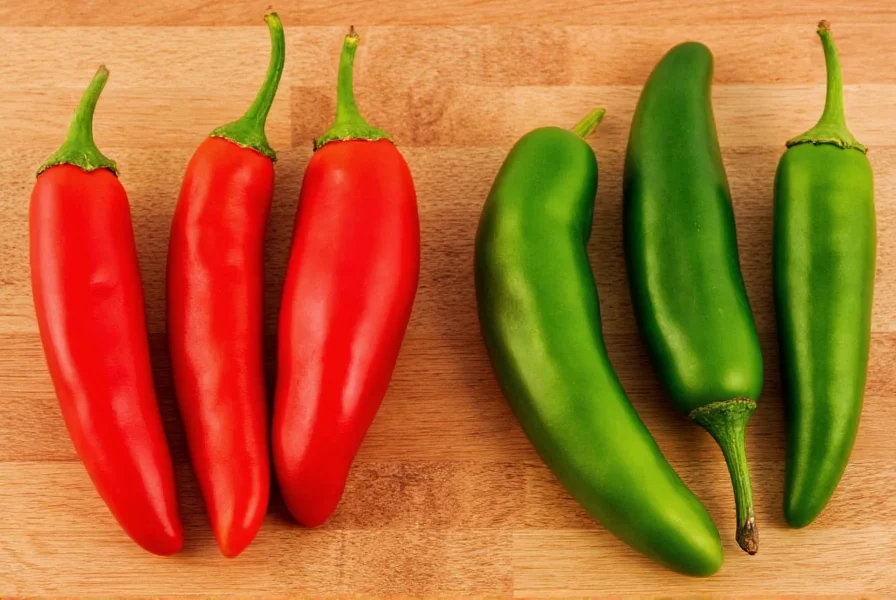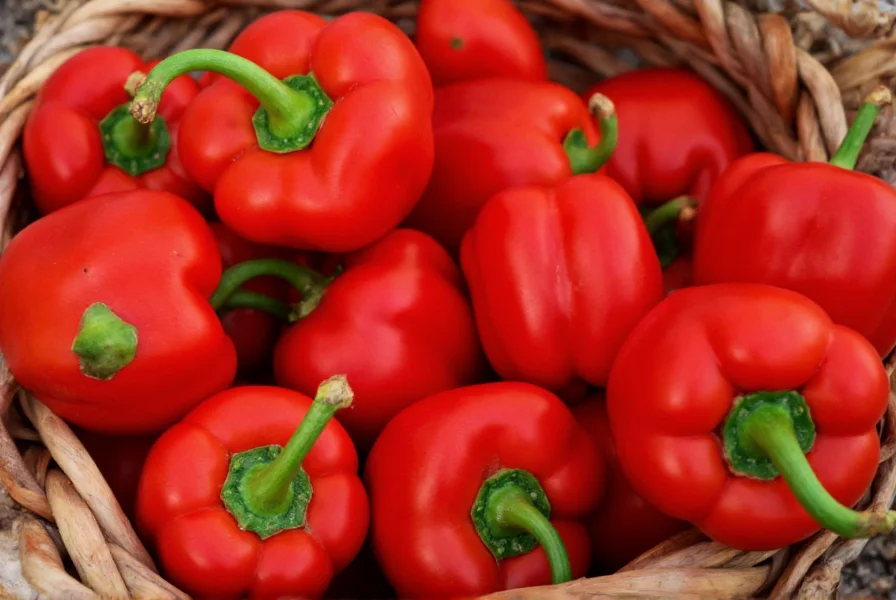Fresno peppers have become a staple in many kitchens for their balanced heat and distinctive flavor. Unlike their spicier cousins, these peppers offer culinary versatility without overwhelming heat, making them accessible to a wider range of palates while still providing that characteristic chili kick.
Understanding Fresno Pepper Characteristics
When you hold a Fresno pepper in your hand, you'll notice its tapered shape and smooth, glossy skin. These peppers typically measure between 2-3 inches in length with a conical shape that narrows to a point. What makes them particularly interesting is their color transformation as they mature. While most commonly encountered in their vibrant red stage, Fresnos actually start green and progress through shades of orange before reaching their final crimson hue.
The flavor profile distinguishes Fresno peppers from other medium-heat varieties. They offer a bright, slightly sweet taste with subtle berry notes that become more pronounced as they ripen. This complexity makes them particularly valuable in dishes where you want pepper flavor without excessive heat dominating the other ingredients.
Heat Level and Scoville Scale Comparison
Understanding where Fresno peppers fall on the Scoville scale helps home cooks and professional chefs alike determine appropriate usage. At 2,500-10,000 Scoville Heat Units (SHU), they sit comfortably in the medium-heat category. To put this in perspective:
| Pepper Variety | Scoville Heat Units | Relative Heat Level |
|---|---|---|
| Fresno Pepper | 2,500-10,000 SHU | Medium |
| Jalapeño Pepper | 2,500-8,000 SHU | Medium |
| Serrano Pepper | 10,000-23,000 SHU | Medium-Hot |
| Habanero Pepper | 100,000-350,000 SHU | Very Hot |
Interestingly, while Fresnos and jalapeños share a similar heat range, most culinary experts note that Fresnos often feel slightly milder in practice due to their higher sugar content. The heat in Fresnos also tends to build more gradually than the immediate punch of a jalapeño.

Fresno Pepper vs Jalapeño: Key Differences
Many home cooks wonder about the differences between Fresno peppers and the more commonly known jalapeño. While they share some similarities, several key distinctions affect how you might use them in cooking:
- Shape and size: Fresnos are slightly smaller and more tapered than jalapeños, which tend to be straighter and thicker-walled
- Flavor complexity: Fresnos offer more fruitiness and subtle sweetness compared to jalapeños' grassier notes
- Heat distribution: Fresno heat builds gradually while jalapeños deliver more immediate heat
- Color variation: While both start green, Fresnos develop more vibrant red hues when fully ripe
- Wall thickness: Fresnos have thinner walls, making them better for quick pickling
When substituting one for the other in recipes, consider that using Fresno peppers instead of jalapeños will yield a slightly fruitier, potentially milder result. For those seeking a fresno pepper substitute for jalapeno in a recipe calling for more heat, you might need to use slightly more Fresno peppers or leave the seeds intact.
Culinary Applications of Fresno Peppers
The versatility of Fresno peppers makes them valuable across numerous cooking applications. Their balanced heat and flavor profile work well in both cooked and raw preparations. Here are some of the best ways to incorporate them into your cooking:
Raw Applications
When used raw, Fresno peppers add bright heat to:
- Salsas and pico de gallo (their thinner walls break down more easily than jalapeños)
- Garnishes for tacos, nachos, and other Mexican-inspired dishes
- Salad dressings and vinaigrettes
- Infused oils and vinegars
Cooked Applications
When cooked, their natural sweetness becomes more pronounced:
- Roasted and blended into creamy sauces
- Added to soups and stews for subtle heat
- Stuffed with cheese or other fillings
- Preserved through pickling (their thinner walls absorb flavors quickly)

Growing Fresno Peppers at Home
For gardeners interested in cultivating their own fresno chili pepper plants, these peppers offer several advantages. They typically mature in 70-80 days from transplanting and produce abundant yields under the right conditions. The plants grow to about 2-3 feet tall and work well in containers or garden beds.
When growing Fresnos, provide them with:
- Full sun (at least 6-8 hours daily)
- Well-draining soil with consistent moisture
- Regular feeding with balanced fertilizer
- Protection from extreme temperature fluctuations
One advantage of growing your own is being able to harvest them at different stages of ripeness. Green Fresnos offer a brighter, grassier flavor, while red ones provide more sweetness and depth. This flexibility allows you to match the pepper's characteristics to your specific culinary needs.
Storage and Preservation Techniques
Proper storage extends the life of your Fresno peppers significantly. When stored correctly:
- Refrigeration: Keep fresh peppers in the crisper drawer for 2-3 weeks
- Freezing: Roast or blanch first for best results when freezing
- Drying: Works well due to their thinner walls; reconstitute in warm water when needed
- Pickling: An excellent preservation method that enhances their natural flavor
- Preserves: Make fresno pepper jelly or hot sauces for longer shelf life
For those wondering how to store fresno peppers long-term, consider making a batch of roasted Fresno pepper puree that can be frozen in ice cube trays, then transferred to freezer bags. This provides ready-to-use portions for future recipes.
Nutritional Profile and Health Benefits
Beyond their culinary value, Fresno peppers offer several nutritional benefits. Like other chili peppers, they contain capsaicin (the compound responsible for heat) which has been studied for potential health benefits including:
- Vitamin C: One pepper provides approximately 75% of your daily requirement
- Vitamin A: Important for vision and immune function
- Antioxidants: Various compounds that may help combat oxidative stress
- Metabolism boost: Capsaicin may temporarily increase metabolic rate
- Low calorie: Only about 4 calories per pepper
While not as intensely studied as some hotter peppers, the fresno pepper nutrition profile makes them a healthy addition to a balanced diet. Their moderate heat level also makes them more accessible to people who might avoid spicier varieties.
Common Questions About Fresno Peppers
Can I substitute Fresno peppers for jalapeños in recipes?
Yes, Fresno peppers make an excellent substitute for jalapeños, though they're typically slightly milder with more fruitiness. When substituting, use the same quantity but be prepared to adjust based on your heat preference. For recipes requiring significant heat, you might need to use slightly more Fresno peppers or include the seeds and membranes.
Are red or green Fresno peppers hotter?
Red Fresno peppers are typically hotter than their green counterparts. As peppers ripen and change color, they generally develop more capsaicin, the compound responsible for heat. Red Fresnos also develop more sweetness and complex flavor notes compared to the brighter, grassier green version.
How do I reduce the heat of Fresno peppers?
To reduce heat, remove the seeds and white membranes (placenta) where most capsaicin concentrates. Soaking sliced peppers in salt water or milk for 15-30 minutes can also draw out some heat. Cooking peppers can mellow their heat slightly, while adding dairy products like yogurt or sour cream when serving provides immediate heat relief.
What's the best way to handle hot peppers safely?
Always wear gloves when handling hot peppers and avoid touching your face. Use a dedicated cutting board for peppers and clean all surfaces thoroughly afterward. If you get pepper juice on your skin, wash with soap and cold water (not hot, which opens pores). For eye exposure, flush with milk or a saline solution rather than water.
How can I use up a surplus of Fresno peppers?
Make roasted pepper puree for freezing, create pickled peppers, prepare fresh salsa or hot sauce, or dry them for future use. You can also share with friends or neighbors, or donate to local food banks that accept fresh produce. For longer preservation, consider making fresno pepper jelly which keeps well in sterilized jars.











 浙公网安备
33010002000092号
浙公网安备
33010002000092号 浙B2-20120091-4
浙B2-20120091-4